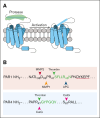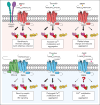From theory to platelets: unraveling the history and complexities of biased signaling
- PMID: 40765916
- PMCID: PMC12320398
- DOI: 10.1016/j.bvth.2025.100073
From theory to platelets: unraveling the history and complexities of biased signaling
Abstract
Biased signaling refers to a phenomenon where a ligand preferentially activates 1 signaling pathway over another at the same receptor. It is best described for ligands that selectively activate G protein-coupled receptors through G protein or β-arrestin pathways. The concept of biased signaling has a rich history that has been experimentally characterized in the past 40 years. As early as the 1970s, models of biased signaling suggested that ligand-bound receptors have a rigid structure, whereas free receptors are fluid proteins with multiple potential active states. Recent cell signaling studies demonstrate that ligands block select signaling pathways but amplify others. This suggests that each ligand can stabilize a unique active conformation supporting the proposed model. Additional studies expanded our understanding of biased signaling to include biased receptors and system bias, which consider the impact of genetic differences and cellular context in which the signal is being studied. This is exemplified in platelet biology. Platelets are nonnucleated cells that rely on membrane receptors such as protease-activated receptor 1 (PAR1), PAR4, and Toll-like receptor 4 (TLR4) to facilitate platelet activation. There is now evidence of biased signaling through PAR1, PAR4, and TLR4 in platelets, making them attractive therapeutic targets. Here, we describe the origins of biased signaling theory and explore the concepts of biased agonists and systems through the lens of platelet activation.
© 2025 American Society of Hematology. Published by Elsevier Inc. Licensed under Creative Commons Attribution-NonCommercial-NoDerivatives 4.0 International (CC BY-NC-ND 4.0), permitting only noncommercial, nonderivative use with attribution. All other rights reserved.
Conflict of interest statement
Conflict-of-interest disclosure: The authors declare no competing financial interests.
Figures



References
-
- Arey BJ. An historical introduction to biased signaling. Biased Signaling Physiol Pharmacol Ther. 2014:1–39.
-
- Koch-Weser J, Schechter PJ. Schmiedeberg in Strassburg 1872-1918: the making of modern pharmacology. Life Sci. 1978;22(13-15):1361–1371. - PubMed
-
- Changeux JP, Kasai M, Huchet M, Meunier JC. Extraction from electric tissue of gymnotus of a protein presenting several typical properties characteristic of the physiological receptor of acetylcholine. C R Acad Hebd Seances Acad Sci D. 1970;270(23):2864–2867. - PubMed
-
- Changeux JP. On the allosteric properties of L-threonine deaminase. I. Methods of studying biosynthetic L-threonine deaminase. Bull Soc Chim Biol (Paris) 1964;46:927–946. - PubMed
-
- Leff P. The two-state model of receptor activation. Trends Pharmacol Sci. 1995;16(3):89–97. - PubMed
Publication types
LinkOut - more resources
Full Text Sources
Research Materials
Miscellaneous
